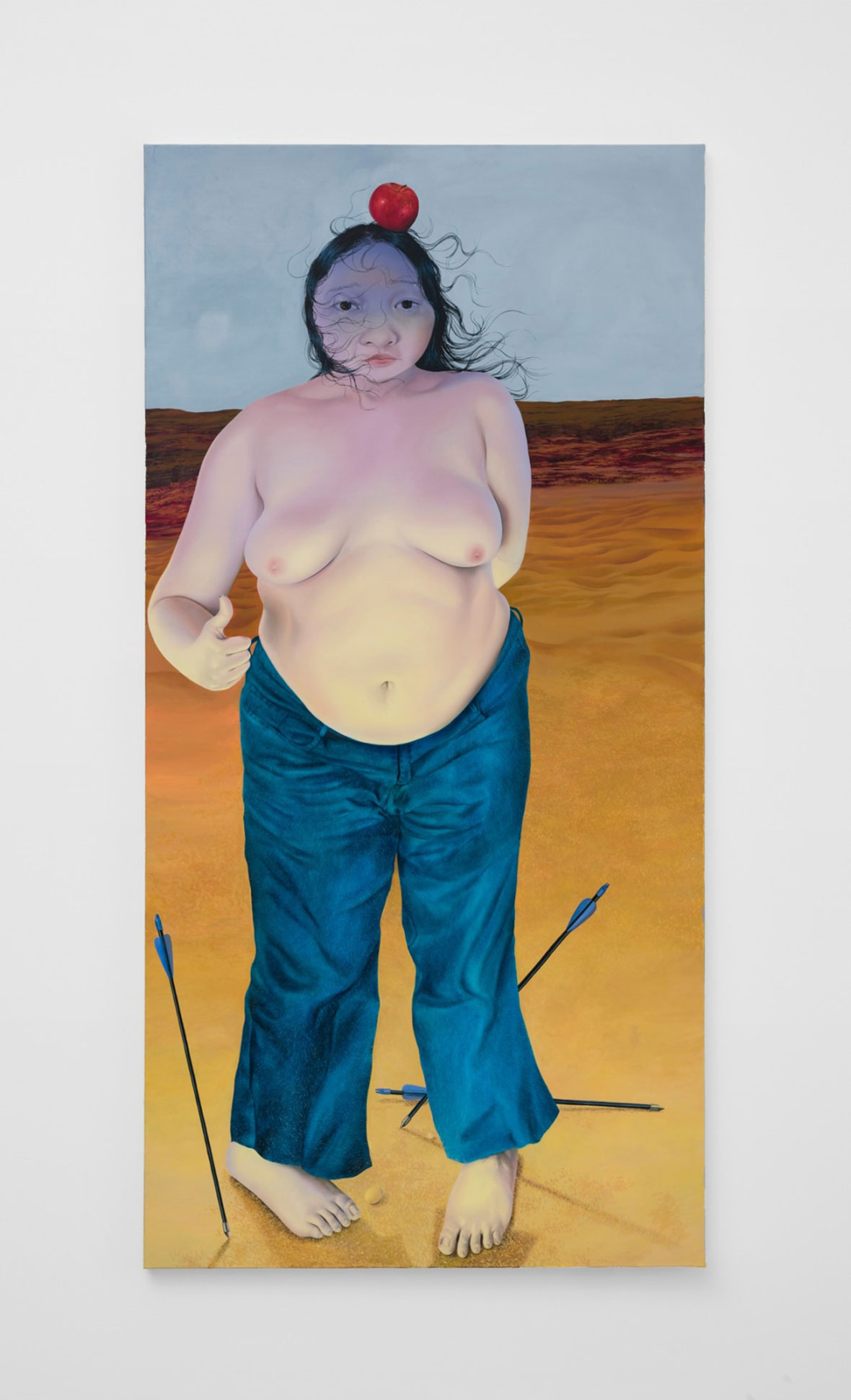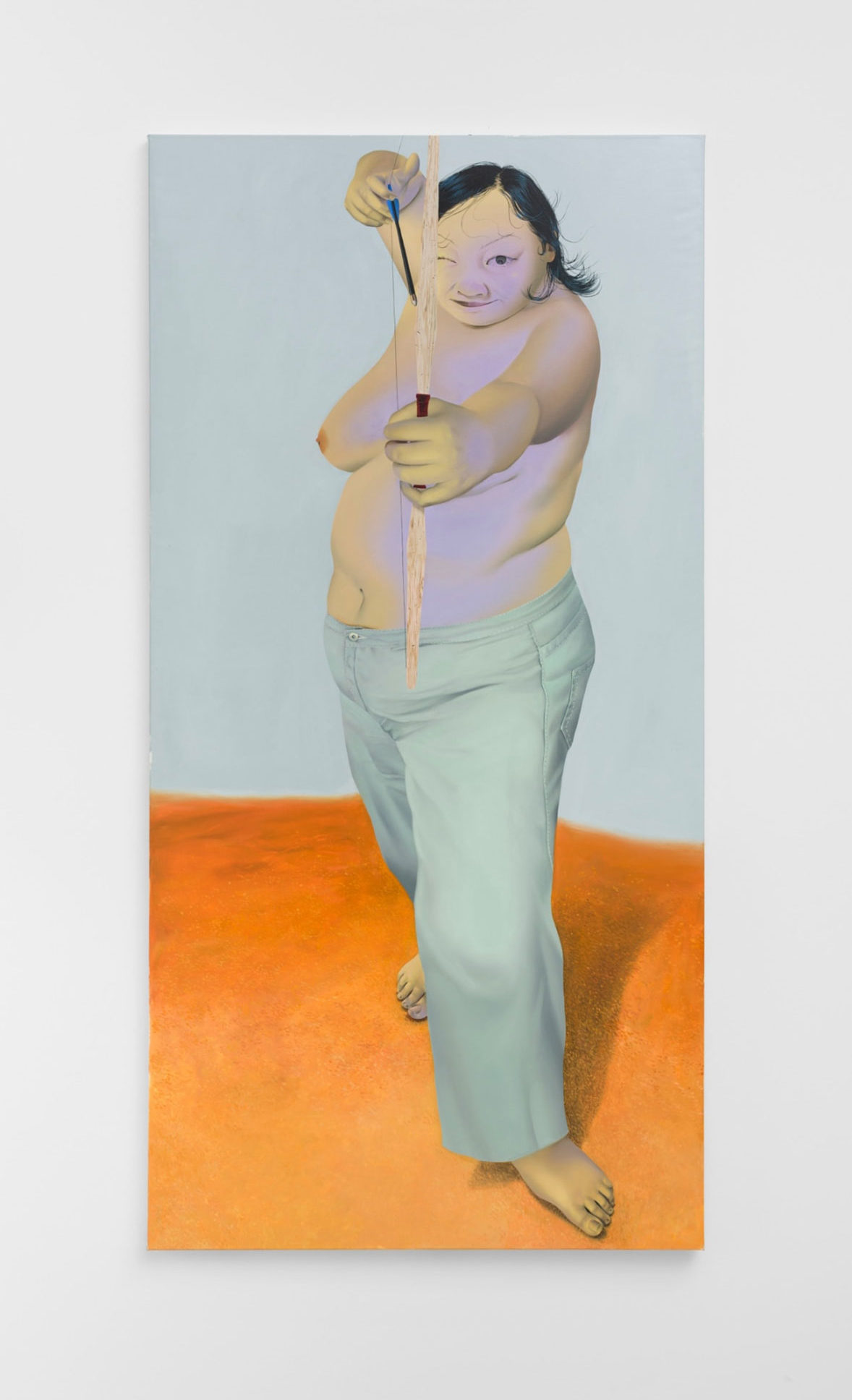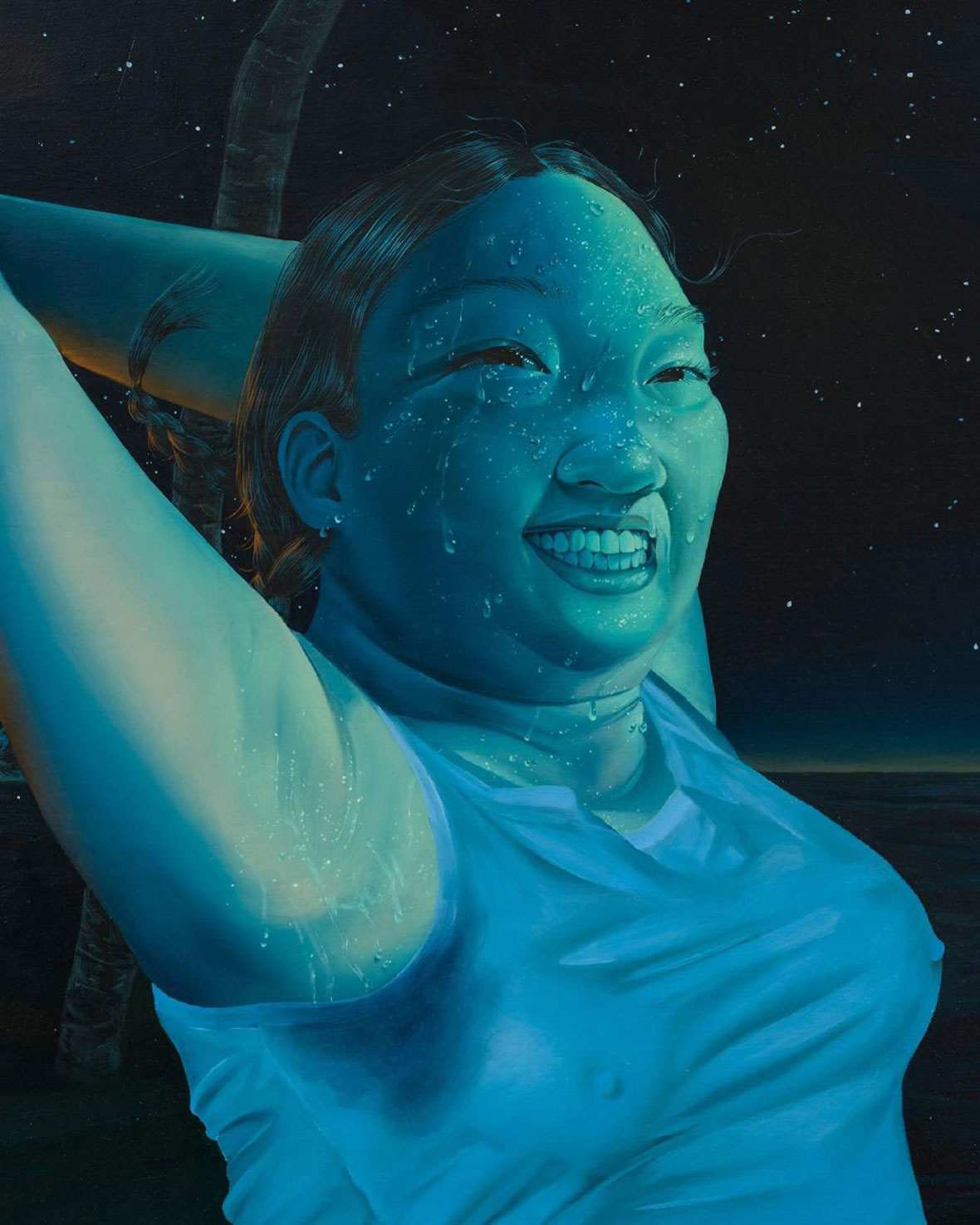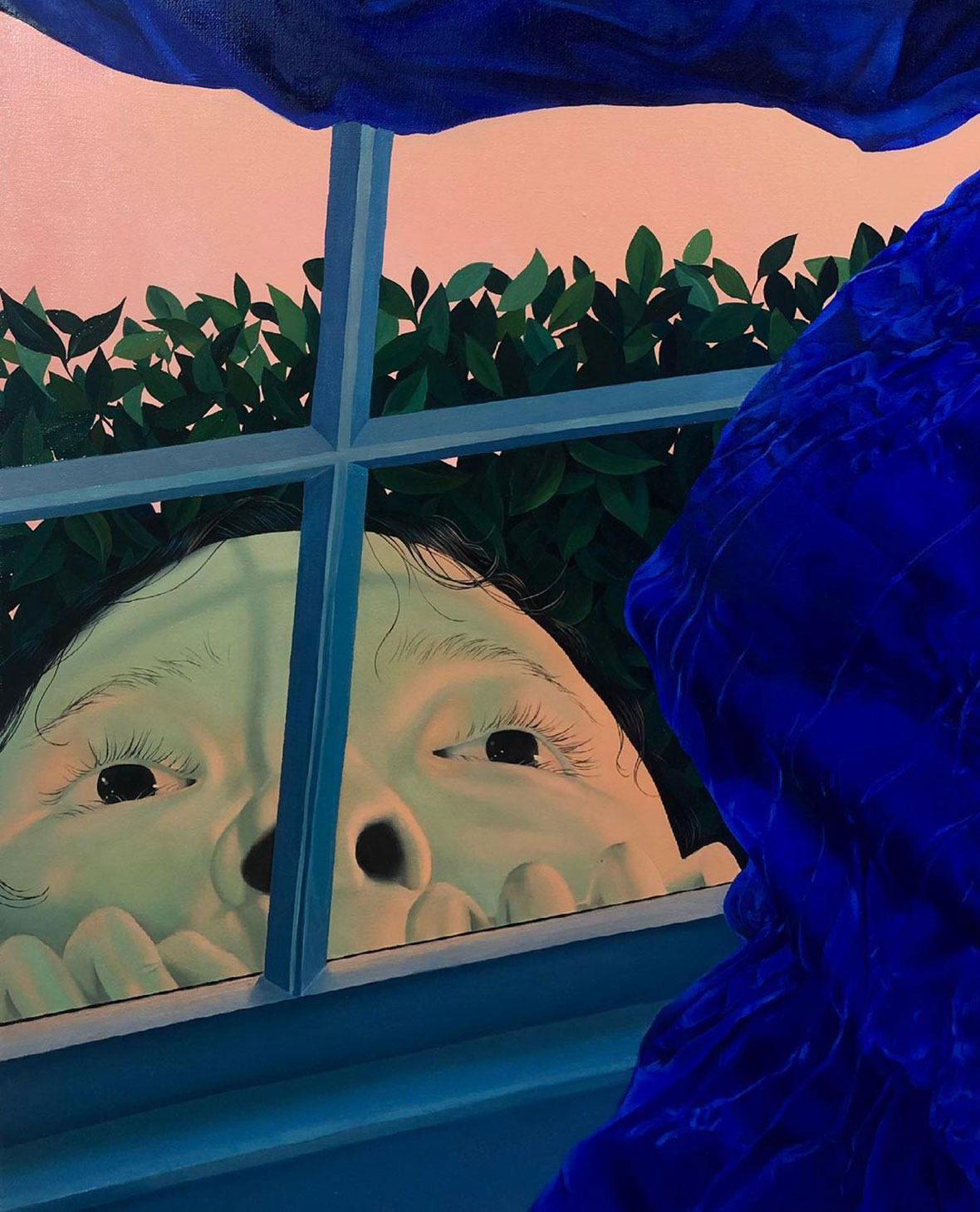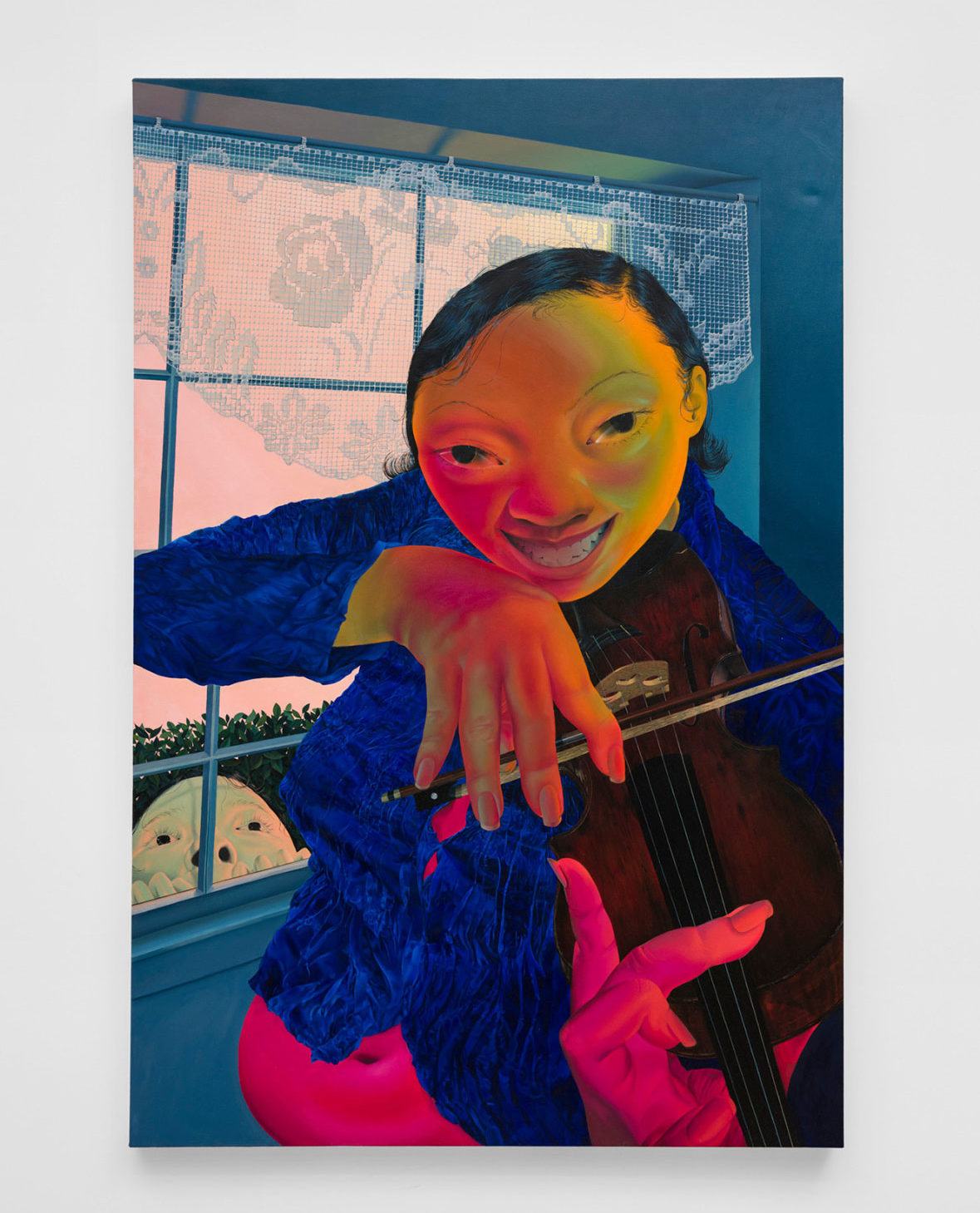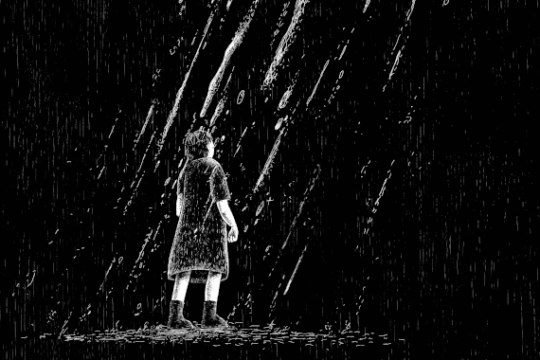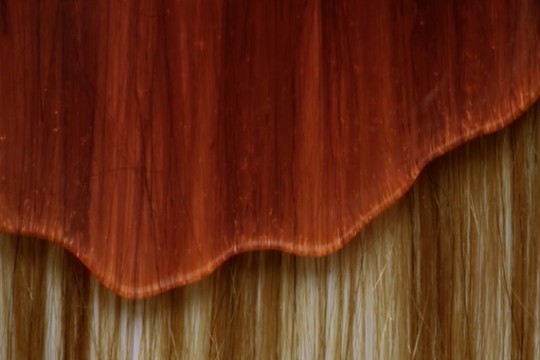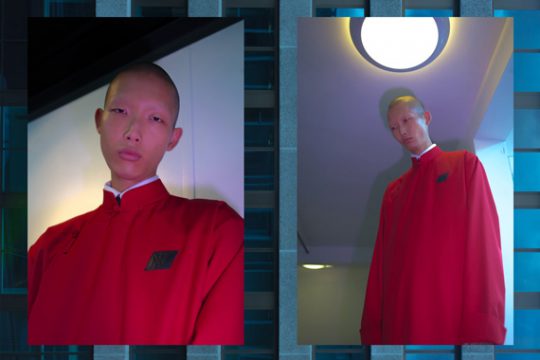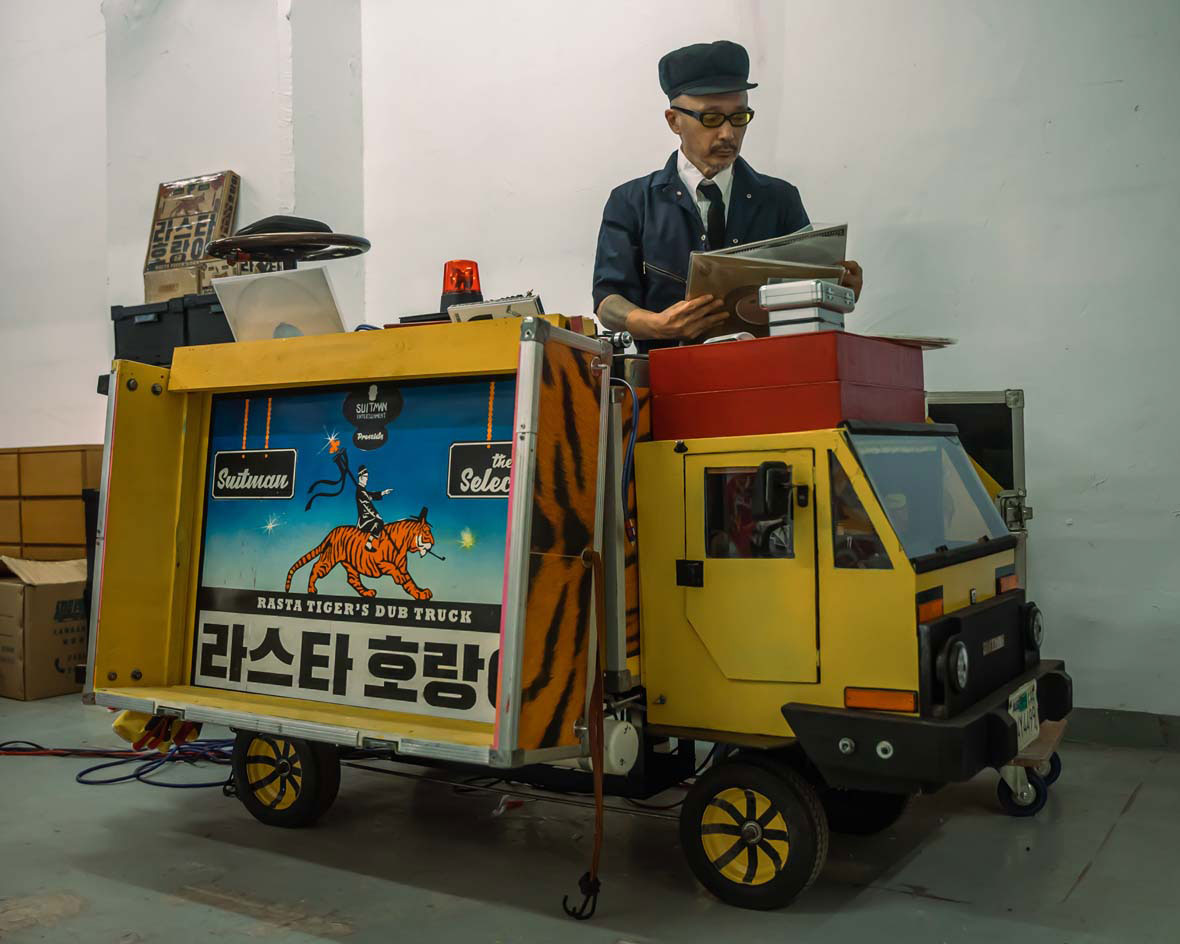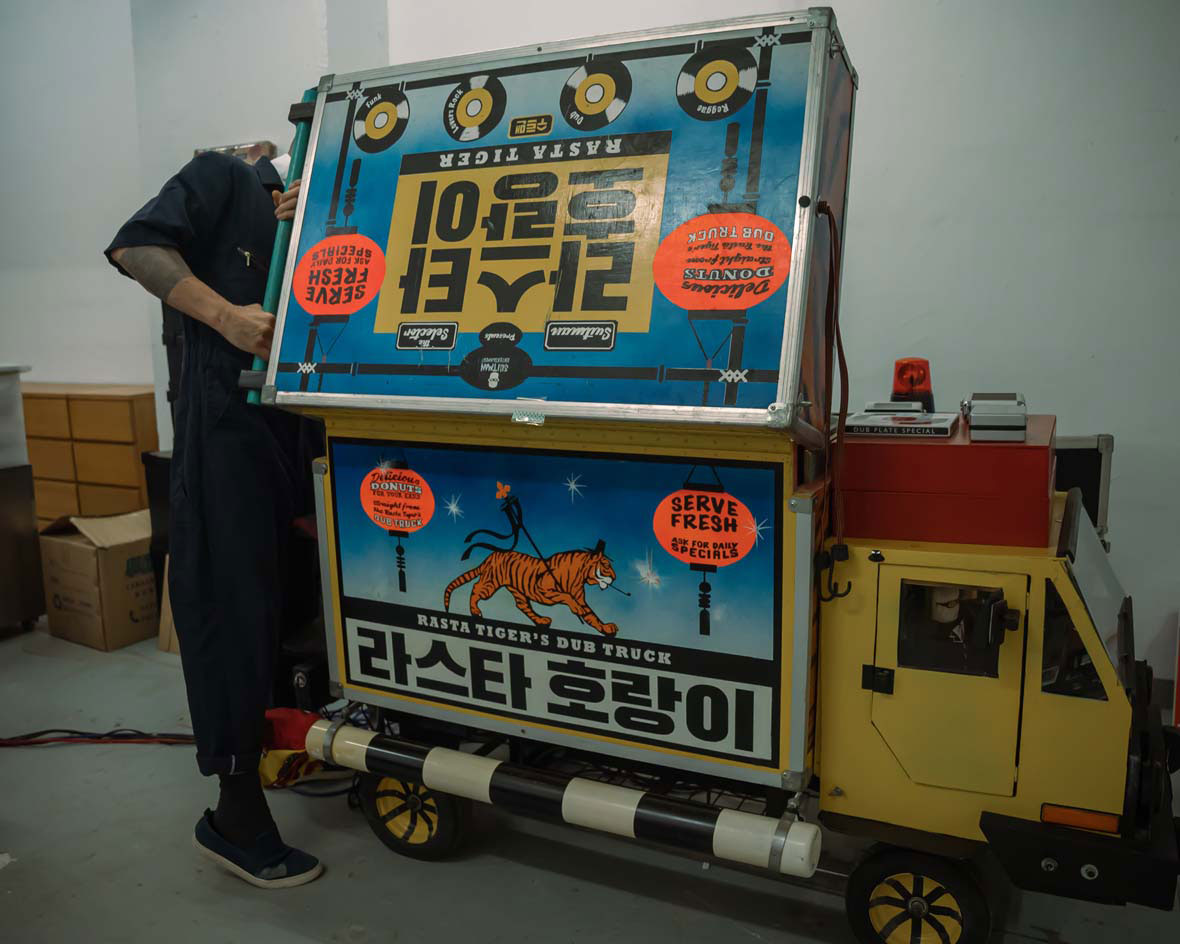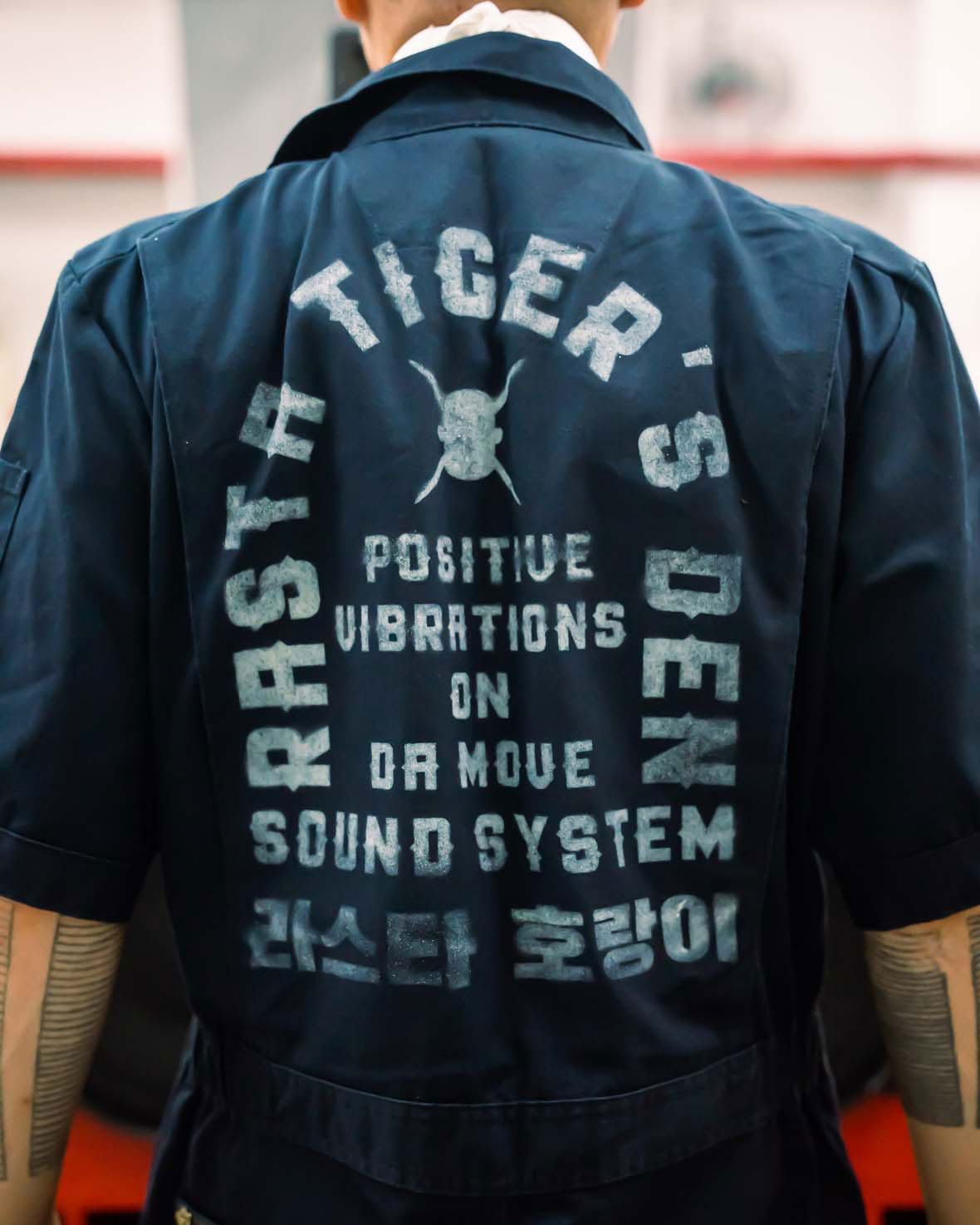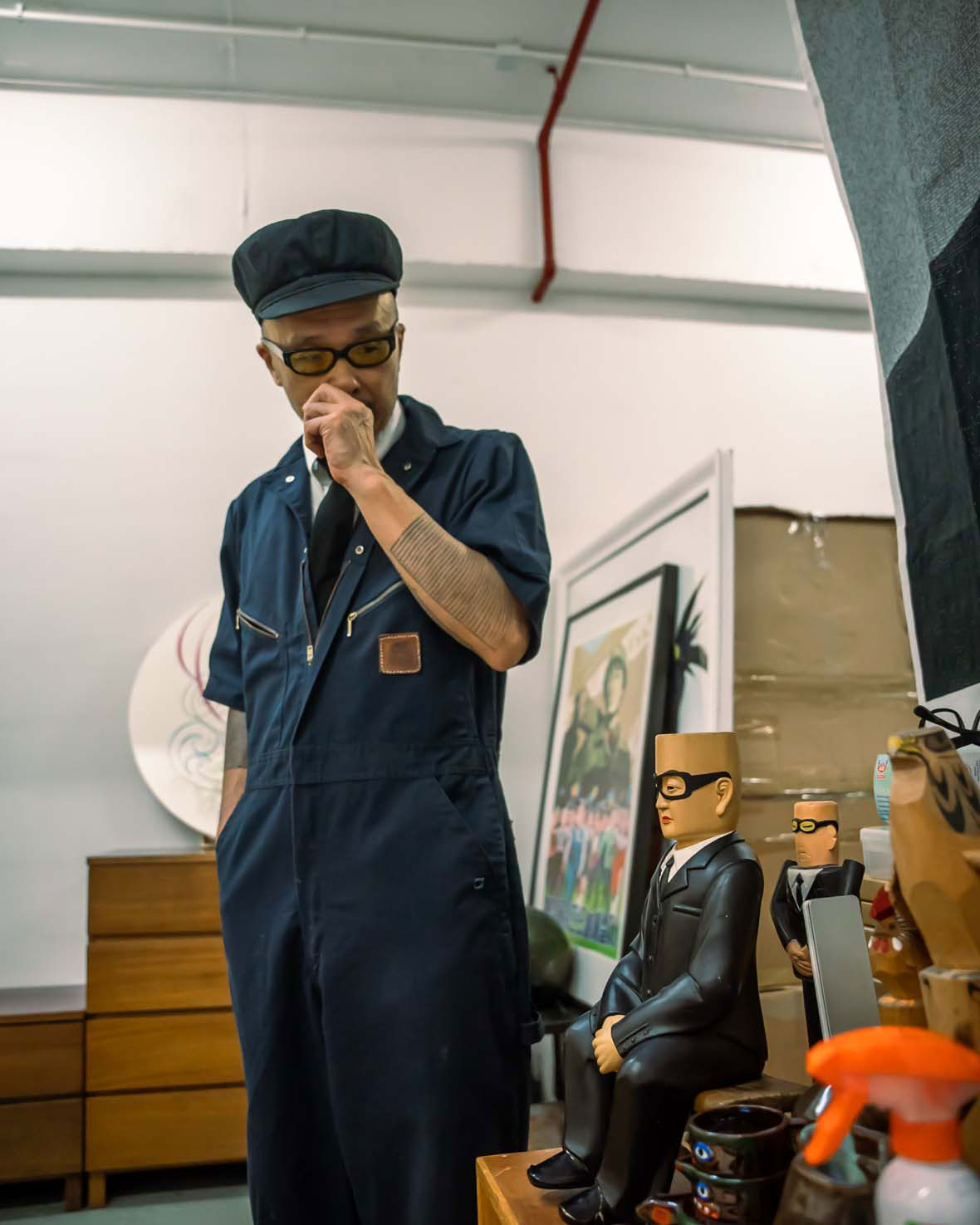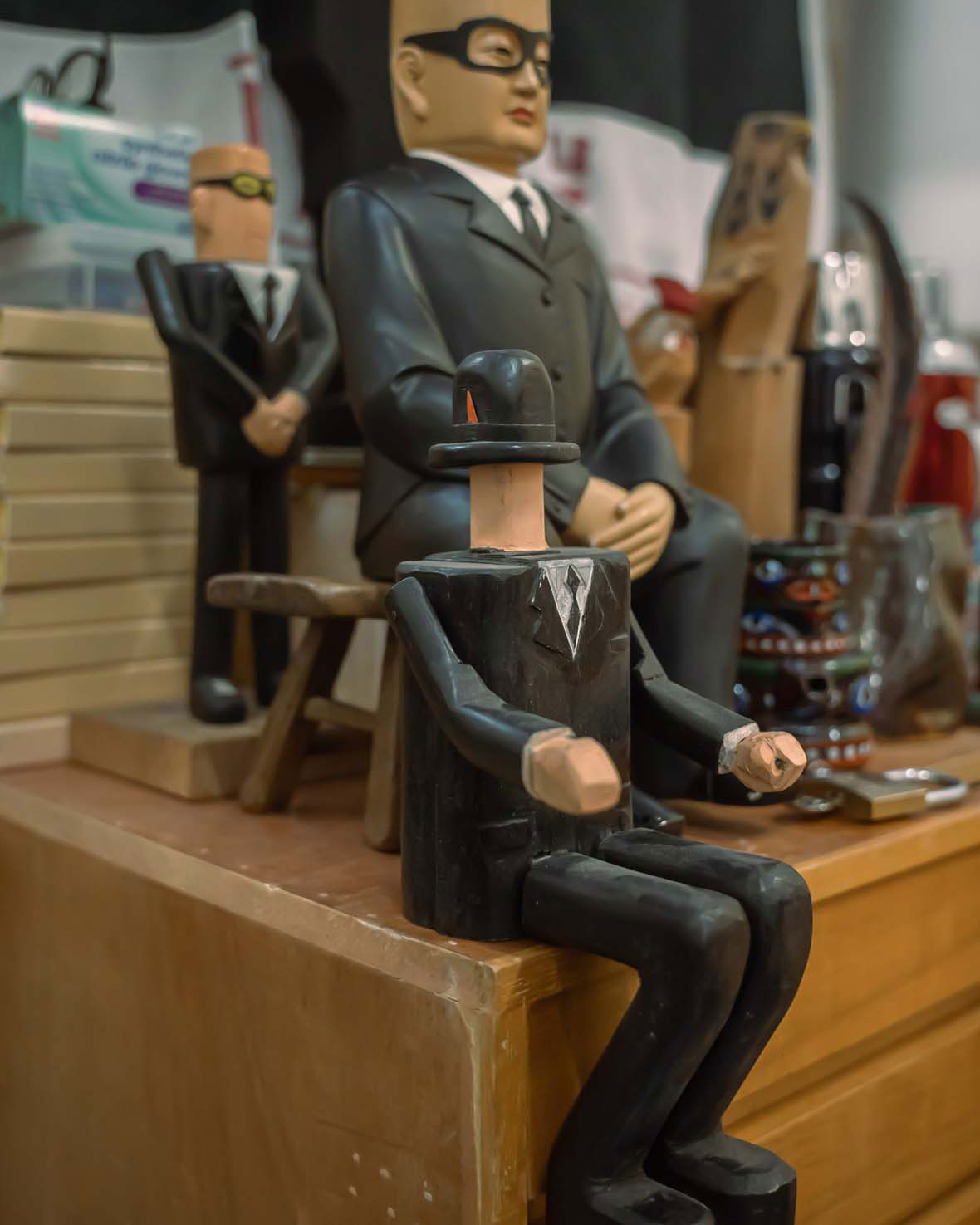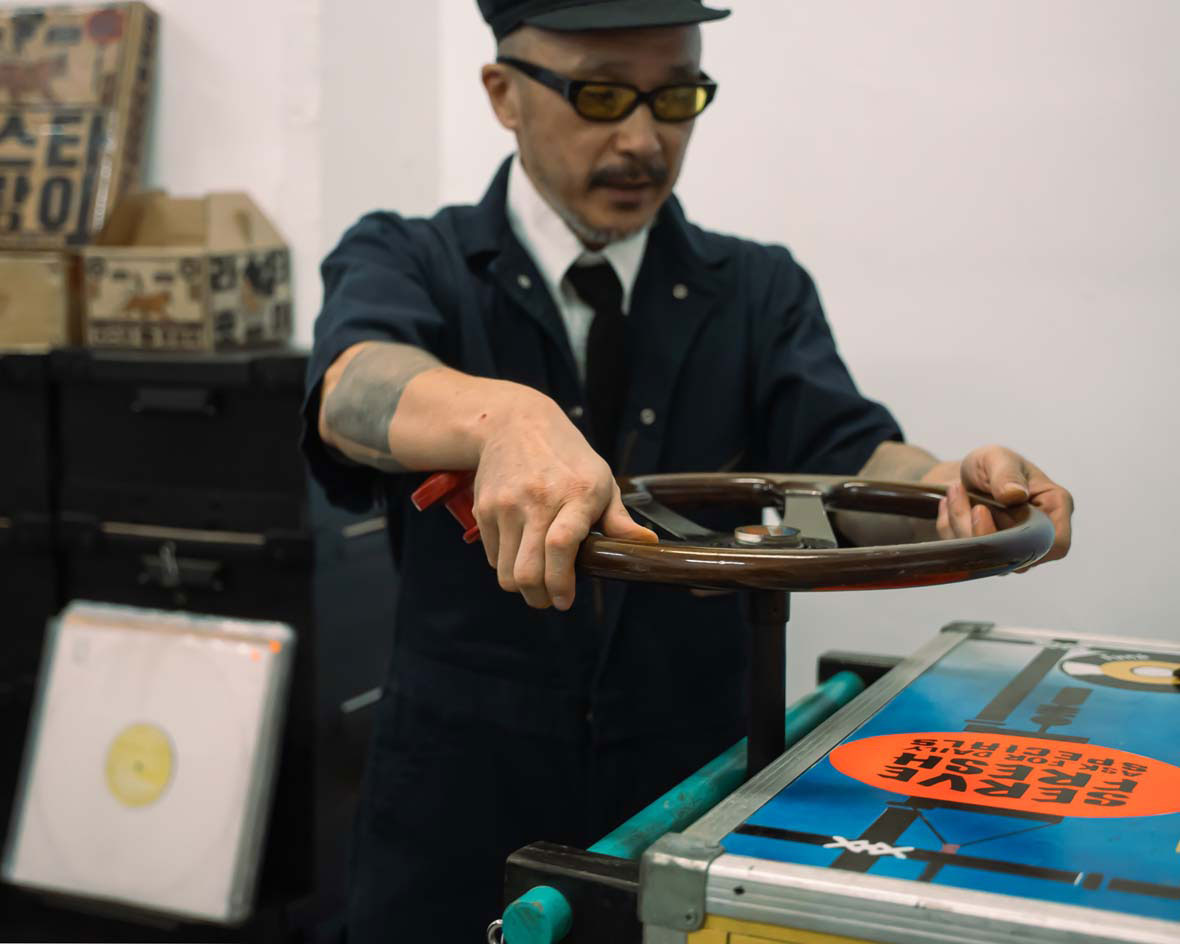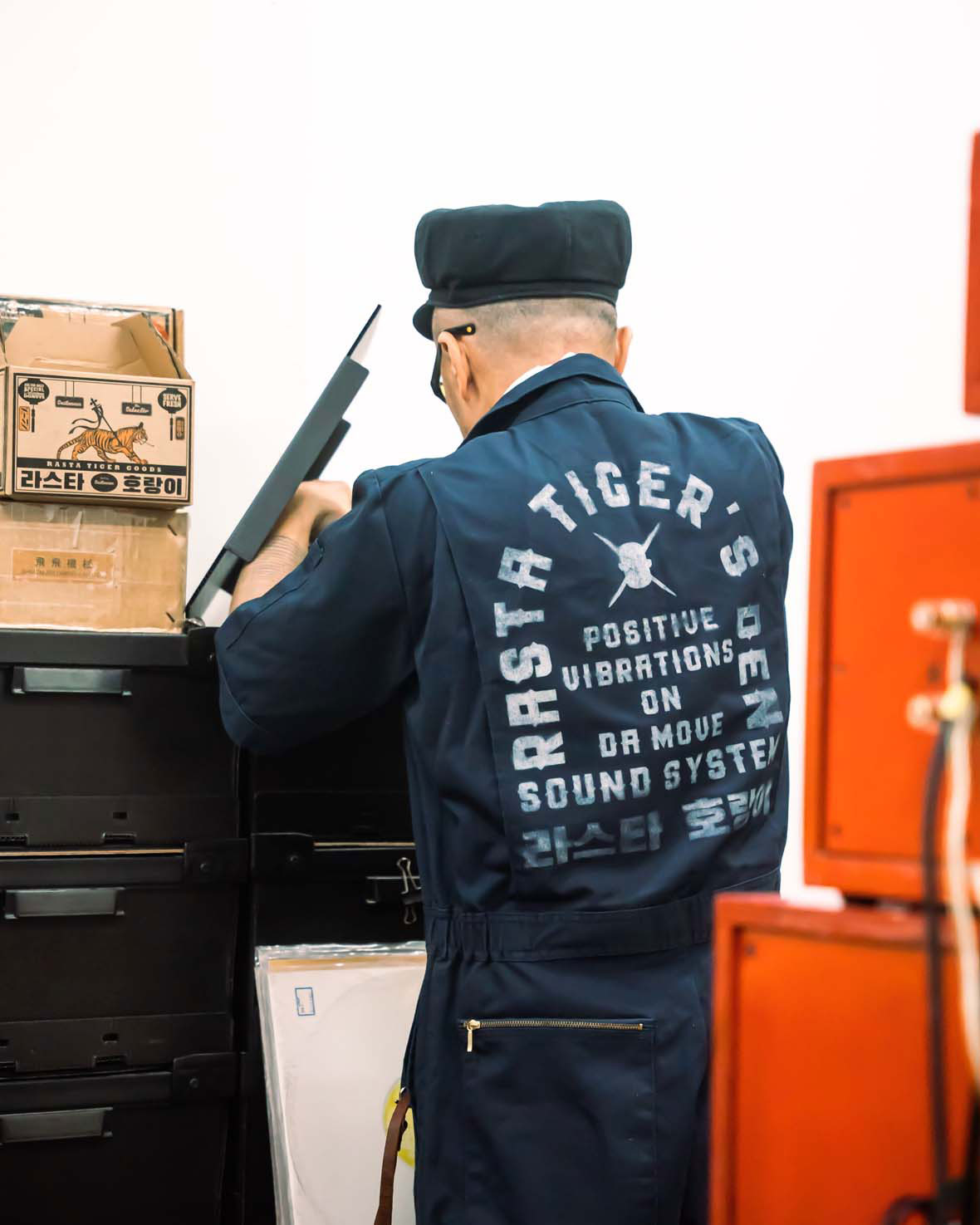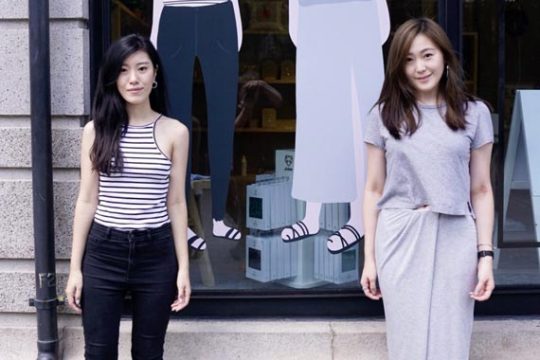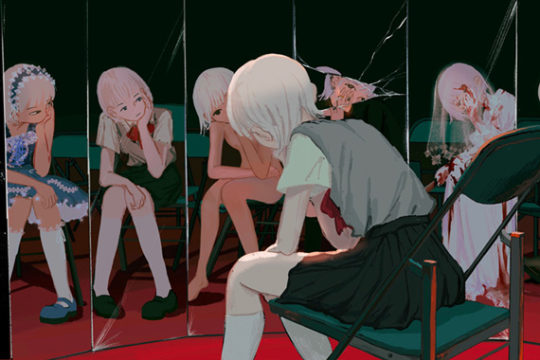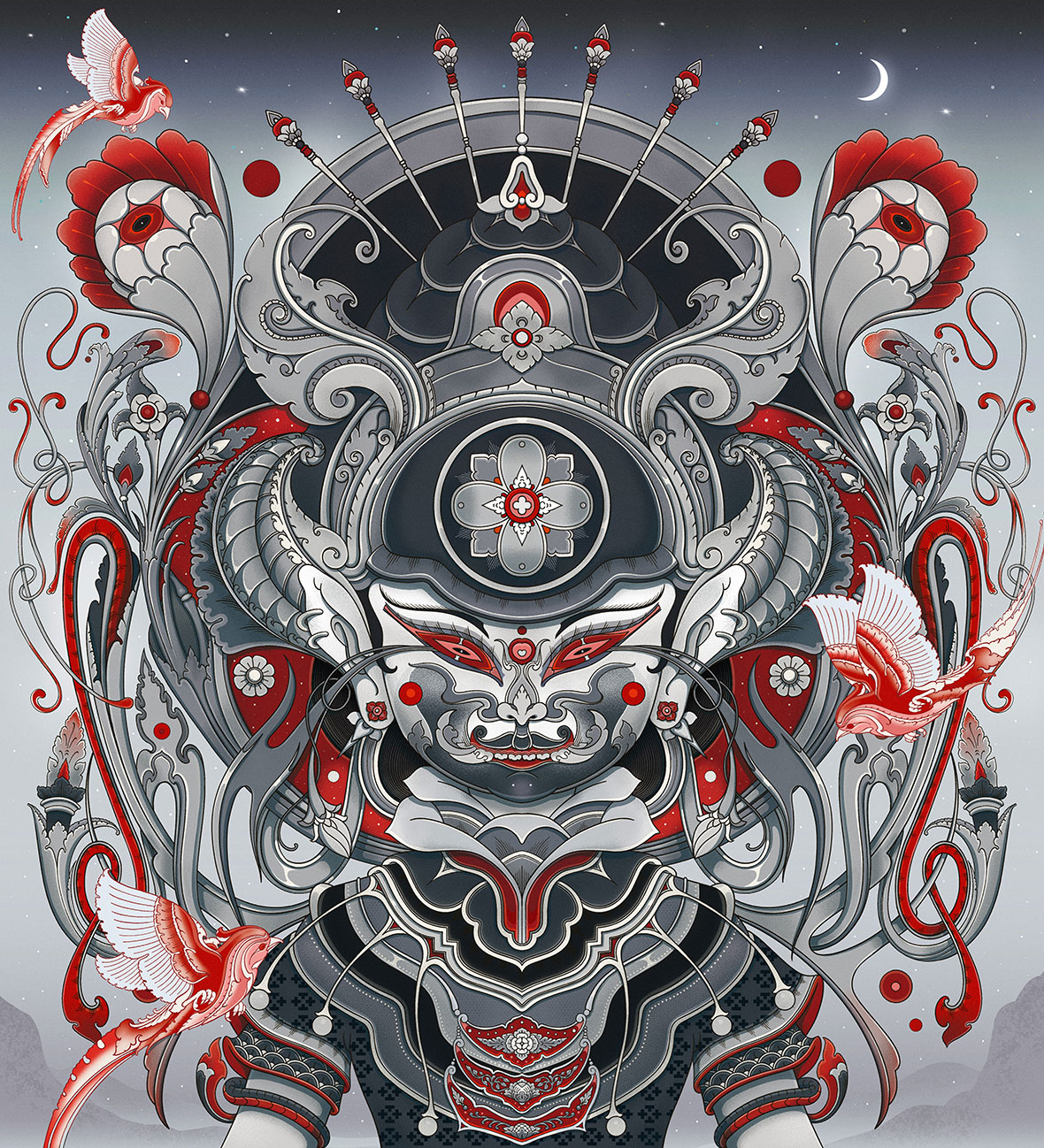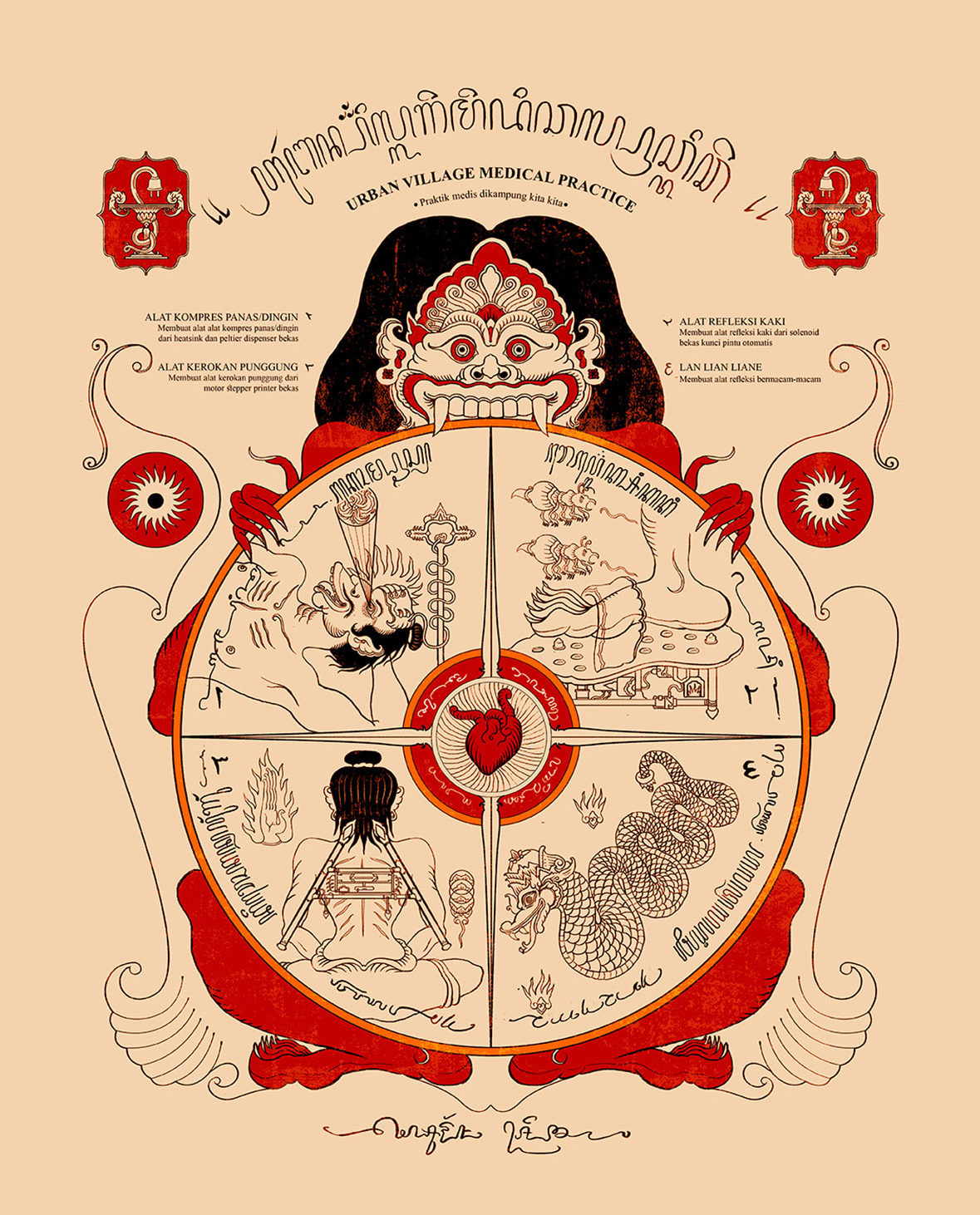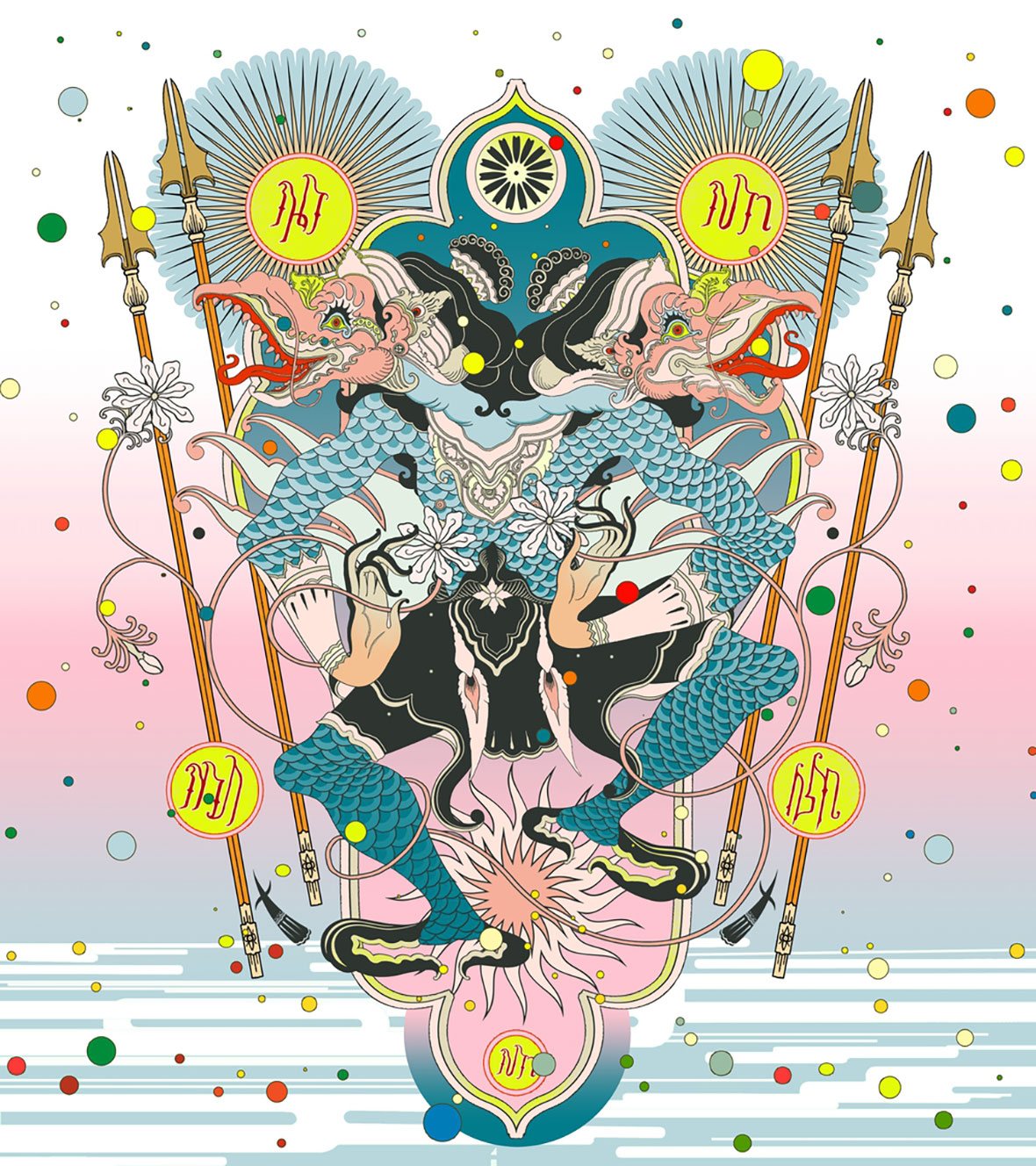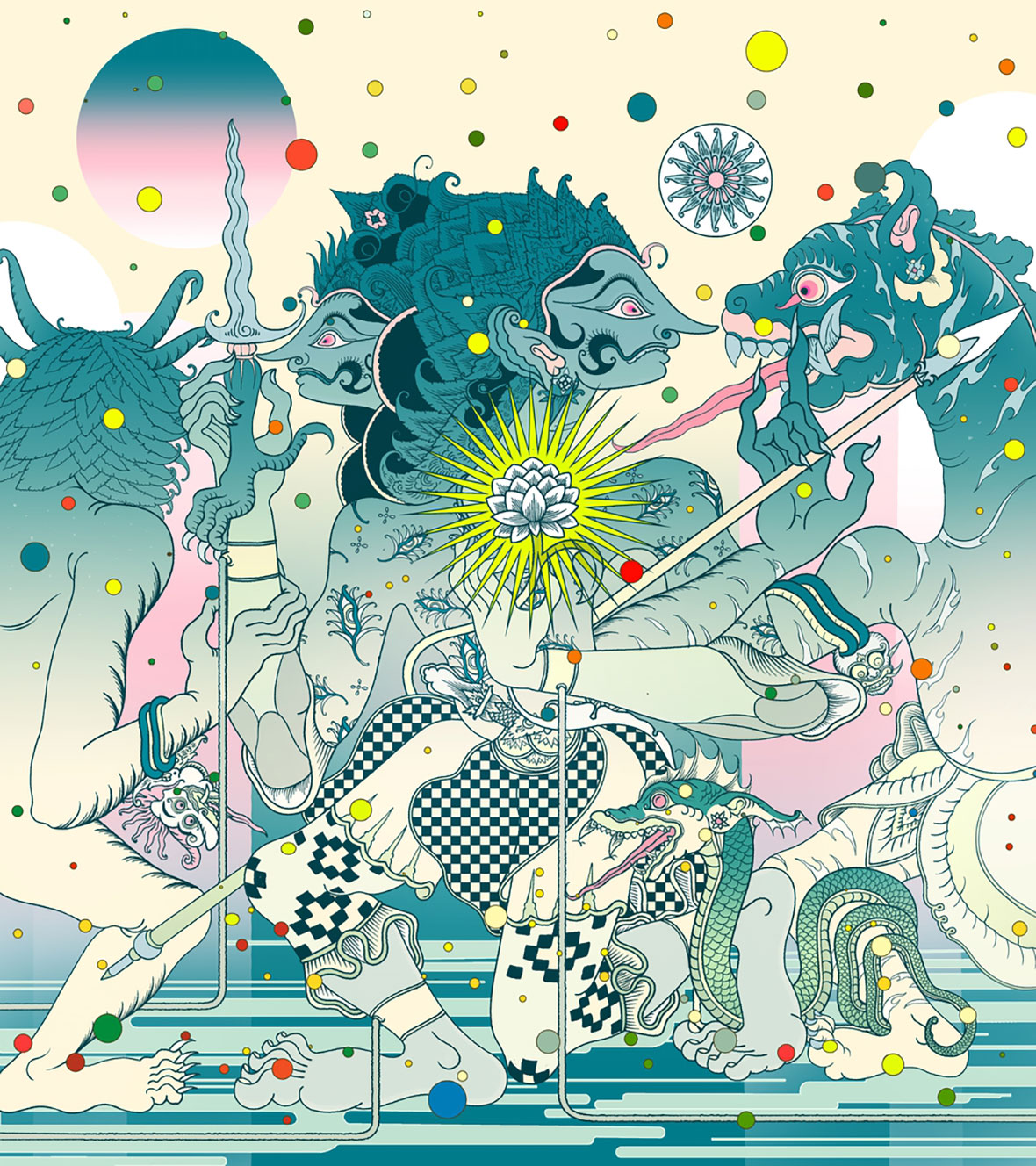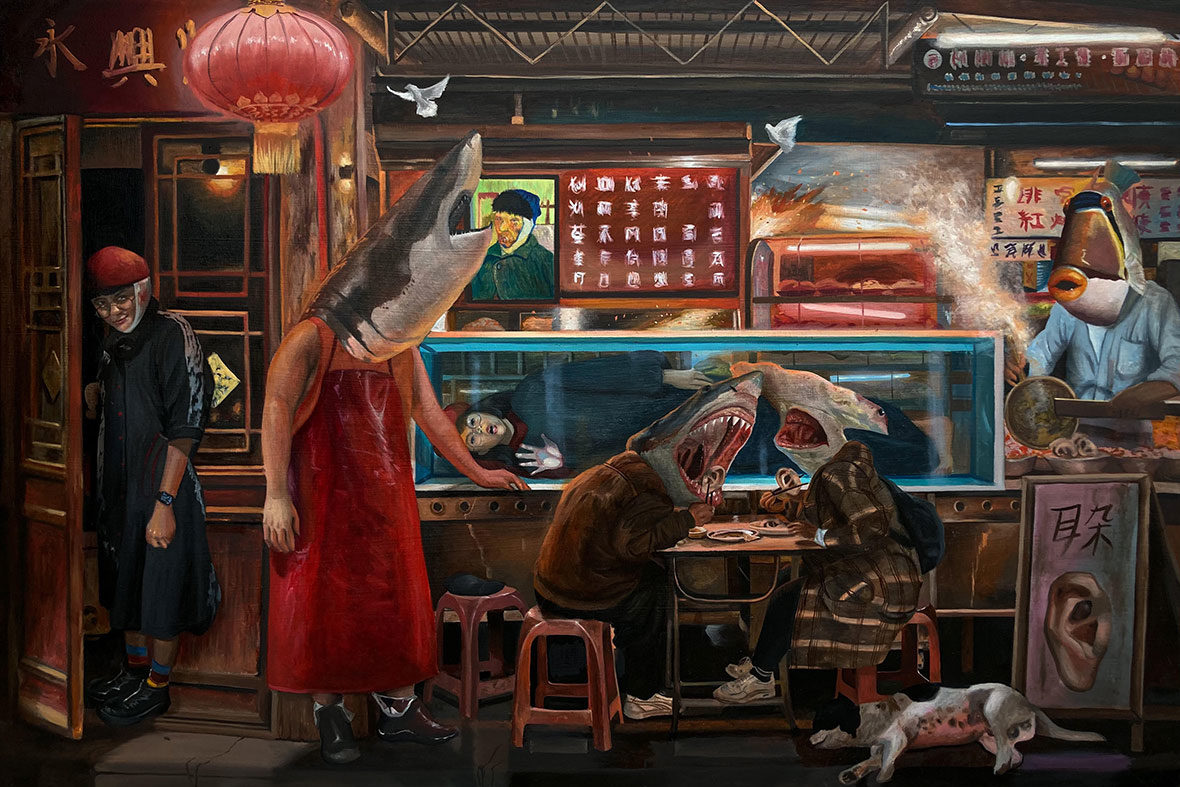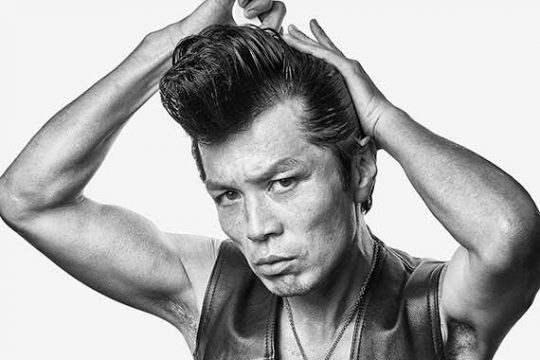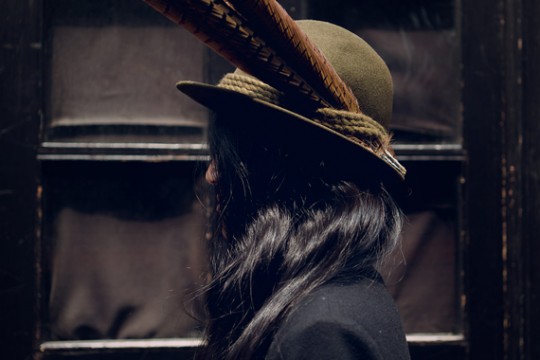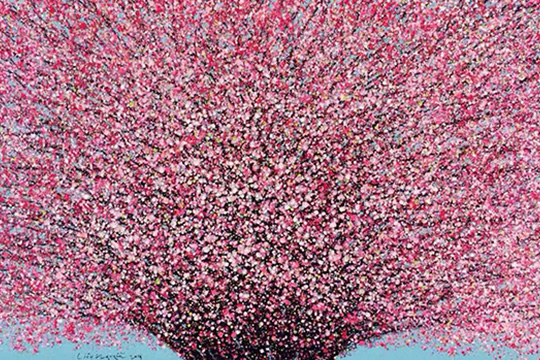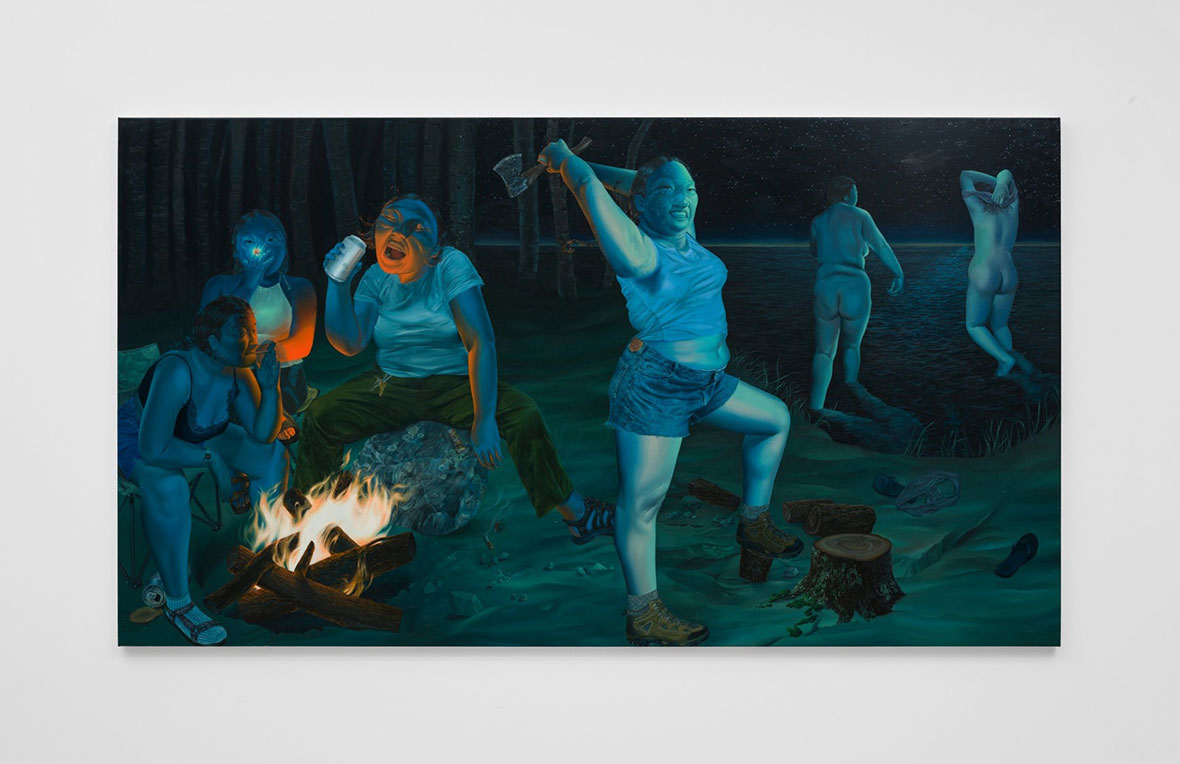
As the largest organ in the body, skin captivates artists for its fluid malleability, frightening vulnerability, and surprising resilience. The folds and stretches of skin wear out as we age, redden as we blush, freckle as we bathe in the sun, and bleed as we hurt. We subject the skin to numerous mutilations for pleasure and pain: tattoo needles, facial chemical peels, piercings, so on and so forth, all for the pursuit of aesthetic beauty as we explore new ways to decorate the indelible surfaces of our skin. Sasha Gordon’s artistic venture into the terrains of skin depictions follows a long line of artists whose worship of corporeal flesh illuminates their works. But unlike the unequivocal and sometimes cruel depictions of flesh often seen in hyper-realistic works, there is a distinctive sense of liberation within Gordon’s epidermal brushstrokes, one that is refined through the artist’s most intimate revelations of herself. In Sasha Gordon’s paintings, the body contorts but never conforms. Though Gordon’s intense anatomical study scrutinizes the figures she paints in a manner similar to Lucien Freud or Jenny Saville, the artist appears much more endeared and charmed by her subjects’ freedom and their child-like spirits. Citing Asian artists such as Ren Hang or Namio Harukawa to be her inspirations, Gordon paints her bodies with a fierce adoration instead of merely relaying their shapes on the canvas. Gordon’s exploration of the uninhibited Asian body resonates with a contemporary desire to see bodies in motion, to see them soak up the wonders of life, to see them under an authoritative autonomy that is antithesis to the regressive ideas of what we have been taught to understand bodies in popular culture. As the artist reconciles with her Asian identity through these paintings, the truth of her figures translates into a radical love for Gordon and her community.
皮肤是人体最大规模的器官,其惊人的延展性、脆弱性和坚固性听起来如此自相矛盾,并吸引一众艺术家围绕皮肤进行创作。随着年龄的不断增长,皮肤在地球重力的影响下起皱、松弛;当情绪发生变化,皮肤的颜色也会跟着改变;它会因为日晒形成雀斑,会因为激素的分泌而遭受青春痘的困扰。人们为了追求快乐与痛苦去改造皮肤,纹身、化学换肤、穿孔等等皮肤改造工程层出不穷。为了追求美,我们不断探索新的方式来修饰皮肤这块无法擦拭的表面。
在受到一系列人体绘画艺术家的影响过后,Sasha Gordon 开始了关于皮肤的创作。在她笔下,皮肤透露出一种独有的解脱,这正是来自她对内心的亲密探索与坦露。她所描绘的人物往往身体扭曲,但从不顺从。
Sasha 所展现的细致入微的人体解剖学令人想起英国画家 Lucien Freud 或 Jenny Saville 的人体绘画作品,但相比后两位,她更着迷于呈现笔下人物的自由精神与孩童般天真的态度。她表示任航和 Namio Harukawa 等亚洲艺术家是她的灵感来源,她带着一种对人体的强烈崇拜来进行创作,而不仅仅是在画布上随意勾勒着肉体之身那么简单。
这些看似无拘无束的身体折射出当代人们的某种愿望,呈现出对于身体高度自主、自治的状态,这与社会主流文化中对于身体的倒退观念背道而驰。她还通过绘画,与自己的亚裔身份寻求和解,这些真实的角色描绘可理解为 Sasha 对自己及其社区的热爱。
Gordon’s predilection for diptychs shines through in her narrative frames with works such as Sore Loser and Campfire. The artist’s playfulness is observed in her characters, with the first painting depicting a tennis match on what appears to be a school playground. As other kids watch and cheer on through the other side of the security gate, the left panel shows the gloating winner delivering the triumphant serve of the game. Running towards the net with a devious look on her face, the winner is flushed with the adrenaline rush of finishing off her opponent. The hems of her white tennis skirt flares up, revealing the sturdy yet soft contours of her legs. On the other side of the net, a portrait of the devastated loser takes up the right panel. The girl exasperatedly slumped down on the tuft, her arms supporting her body from completely falling down to the ground. On her face is an expression of disbelief, which Gordon had cleverly colored with a blue-purple hue that sharply contrasted her bright yellow shirt. Her right leg extends through the net and almost touches the edge of the canvas. The girl had already given up as the tennis ball was still mid-air in motion. Witnessing her own concession, the sore loser has no other choice but to simply anticipate her defeat as she watches the ball seals her fate. Two oppositional emotions take place on two separate panels, and the distinction between one and another is glaringly obvious. Yet, this is one of Gordon’s more straightforward work, an exercise in storytelling and a practice in form, albeit a masterful one. The aesthetics Gordon has refined is clearly captured through expressive movements of bodies effortlessly choreographed in motion as well as the conspicuous expressions of her characters. At the core of her works, Gordon assumes the positions of many sides, setting herself up as someone who knows what both winning and losing feels like.
Sasha 偏爱创作双联画,这一点从她的叙事性作品《Sore Loser》(输不起的人)和《Campfire》(篝火)可见一斑。她笔下的角色同时也反映出她诙谐的个性。《Sore Loser》(输不起的人)描绘了一场在学校操场举行的网球比赛。整幅作品以球场的栅栏将画中角色分饰两端,一边是围观比赛的孩子们,他们呐喊助威,热情洋溢;另一边则是胜负已分的两位运动员,获胜者带着得意的表情跑向对手。白色网球裙下摆扬随风扬起,露出结实的腿部轮廓。失败者恼怒地瘫倒在地板上,靠双臂支撑疲惫的身体才不至于完全瘫倒在地上。Sasha 巧妙地运用蓝紫色突显失败者那不知所措的神情,与她明黄色的衬衫形成鲜明对比。女孩的右腿穿过球网,直抵画布的边缘。半空中的网球还未落地,但显然她已经放弃,无计可施地,只能眼睁睁看着球划过中线,以此宣布她的落败。
两种对立的情绪发生在两个独立的画面上,彼此鲜明的对比为描述内容增添冲突气息。这是 Sasha 较为直接的作品之一,是她对叙事方式与形式的实践,展现出高超的张力。富有表现力的身体轮廓,加上不加掩饰的表情,清晰地展现出 Sasha 独有的美学特点。在创作中,她往往会设身处地体会不同角色的立场,从赢家和输家双向考虑。
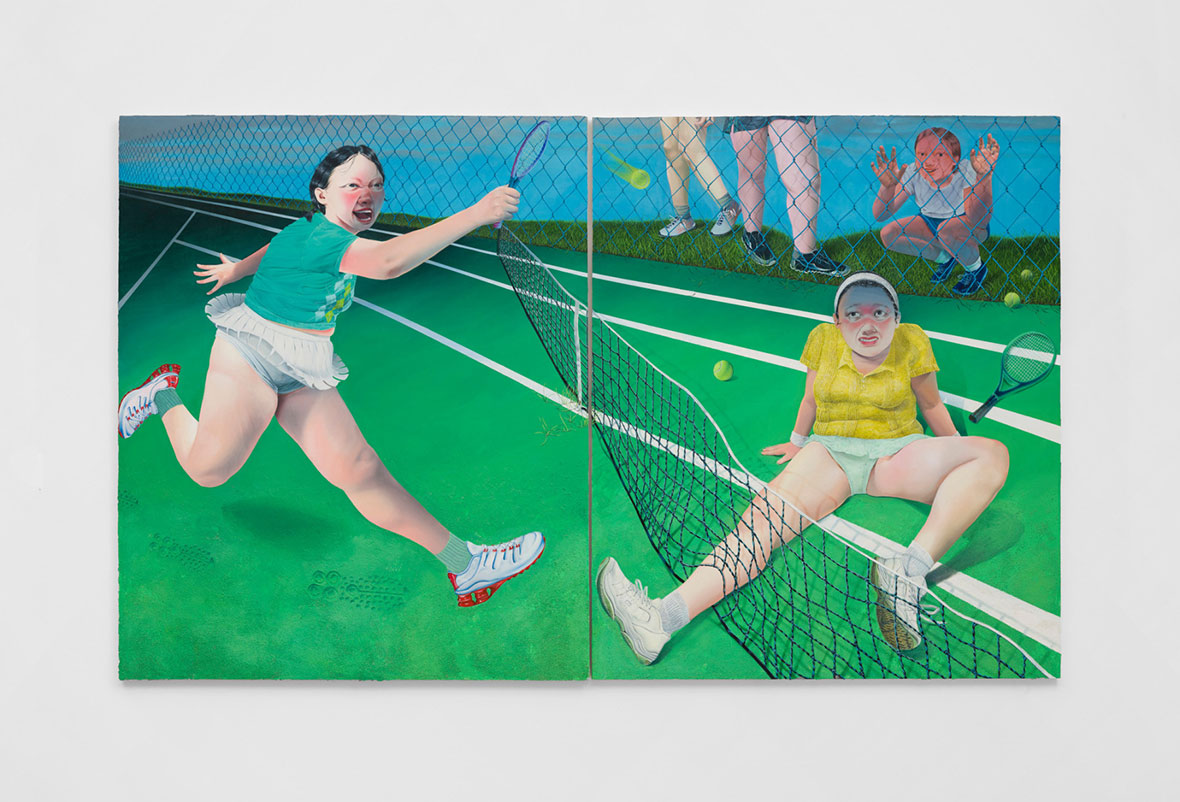
Shifting from day to night, Gordon’s subjects still glow in the dark with many curiosities and adventures. In the rowdy intimate scene of Campfire, a friend group enjoys one another’s company in their woodland rendezvous. Here, the bodies appear uninhibited by the anxieties of the modern world: singing into a beer can, enjoying a midnight cigarette, chopping woods, and venturing towards the lake for an impromptu skinny-dipping. Pleasure permeates these portraits, as the bodies Gordon paints are left to do what they do best: having a good time. Surrounded by the eerie serenity of the forest, all of the friends are left to perform for no one, because no one is around. Their primary task of the night is to bathe in whatever nature has got to offer, to reconnect with the liberty that comes from letting your senses immerse in screen-less joys. Though the blue hues in Sore Loser signifies a disappointing emotion, in Campfire, it points to the neutralizing power of nature to let bodies be bodies and take up as much space as they possibly can. Campfire is an effervescent and freeing portrait of young twenty-somethings slowly making their ways back to childlike spirits by allowing for simple leisure that so many yearns for.
作品《Campfire》(篝火)则描绘了黑暗树林中的场景,一帮好友三三俩俩,透露出冒险意味与好奇心。画面上,每位角色都用肢体语言,宣示着对现代世界的烦恼焦虑和不屑:他们举着酒杯,嘴里叼着香烟,有人肆意砍伐草树,有人则大胆地走向湖边,来一场即兴的裸泳。仿佛每个人脸上都洋溢着愉快,这是她们最擅长的事情:纵情享乐。
在远离人类生活的寂静中,人们不需要为任何人表演。她们唯一要做的,就是沉浸于大自然所提供的一切,重新让所有感官充分感受没有手机或电脑屏幕的自由与乐趣。在上幅作品《Sore Loser》(输不起的人)中,蓝色象征着失望与沮丧,而在作品《Campfire》(篝火)中,蓝色被填充在整幅画面,代表大自然的平衡,即让身体回归本身。画面上这帮自由的二十岁出头的年轻人,通过享受所有人渴望的简单与轻松,逐渐唤醒观众内心的童真。
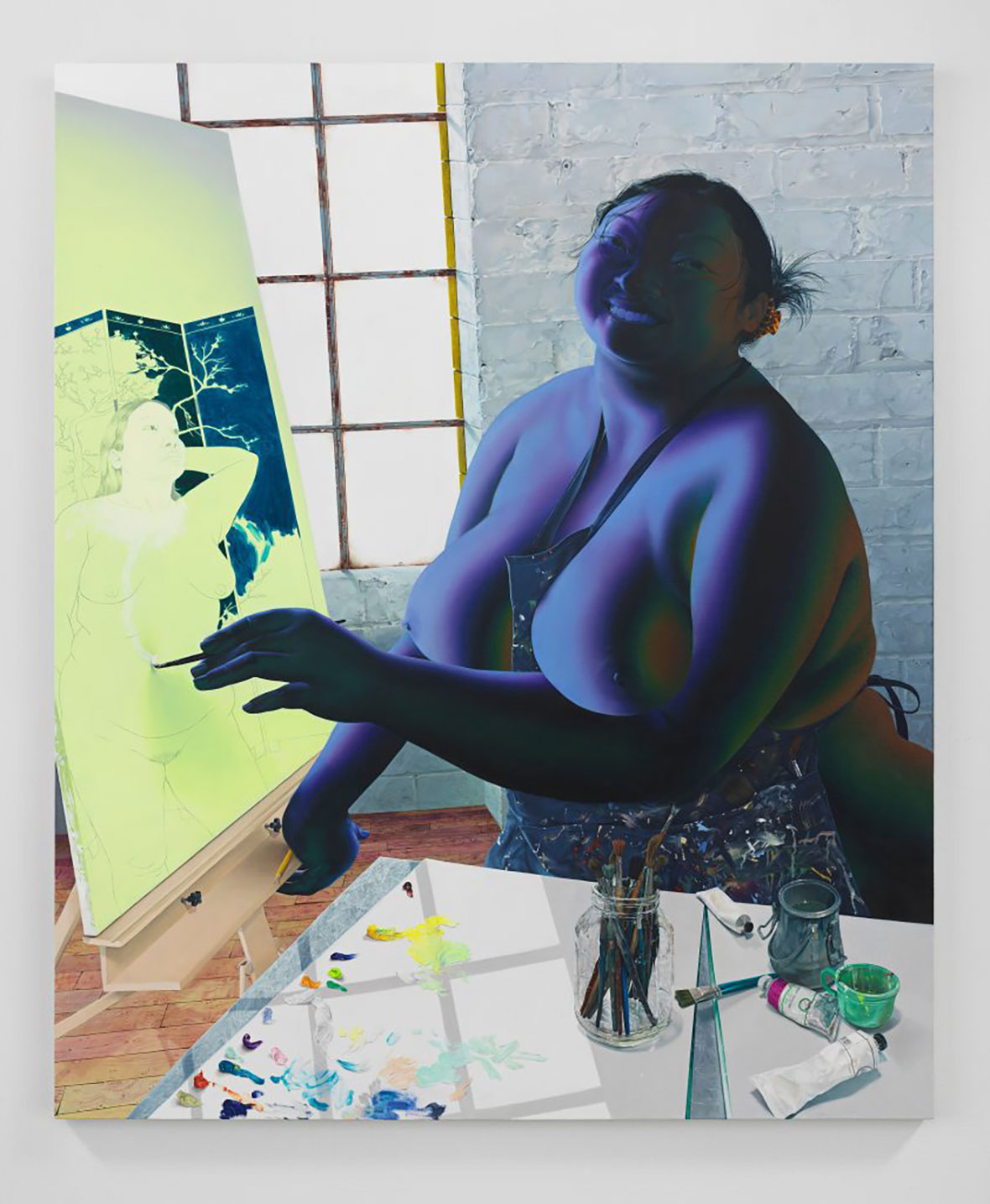
Gordon often ponders about the gazes that others subjected her to. Existing as a plus-size queer biracial woman, the artist is at the center of complicated conversations about intersectionality and racial projections, as she vocalizes in interviews. Gordon speaks extensively about her heightened spatial awareness due to growing up in the majorly white and heteronormative neighborhood as the daughter of a Polish-Jewish-American father and a Korean immigrant mother, saying how she “became very aware of [her] body in space.” The canvas provides the artist room to explore the tension between internal desires and external forces, as the artist meditates on perception, growth, permanence, and judgment. It is true that no one can control what others think of them. But for those in the marginalized communities, asserting their individuality becomes even more of a daunting Sisyphean task, as others’ understandings of their personhood is implicitly entangled in a painful history of prejudice, colonialism, and racism. Gordon’s identity as a queer Asian woman magnifies the complications, as she professes, “Growing up, I felt there is the “me” who is present but there’s also this other, external force that’s judging and controlling what I do… A lot of my work makes you question who the viewer is and what power they have over the subjects in the painting – who usually have these startled facial expressions, or sometimes they’re menacing or giddy. It’s very dependent on who the viewer is and how they relate to the work.”
Sasha 经常在意别人对她的目光。作为一名大码酷儿混血女性,她表示自己就处在性别、种族这一复杂话题的中心。Sasha 的父亲是波兰犹太裔美国人,母亲是韩国移民,从小在白人异性恋社区长大的她,对身体有着强烈的空间意识。而画布为她提供了探索内部欲望和外部力量之间张力的空间,并思考关于感知、成长、永恒和评判的问题。
事实上,没人能控制他人对自己的看法。但对于边缘群体来说,维护自己的个性变得更为困难,甚至是一种西西弗斯式的徒劳,因为他人对自己人格的理解隐含地掺杂着一段充满偏见、殖民主义和种族主义的历史。Sasha 作为亚裔酷儿女性的身份让这个问题更加复杂,正如她所说,“在成长过程中,我觉得有一个‘我’,但同时也有其他外部力量在判断和控制我的行为……我的很多作品会让人疑问,观众是谁?他们与画中那些露出惊讶、险恶或轻佻表情的角色有着怎样的联系?而这个问题的答案,在很大程度上取决于观众自己。”
Gordon finds acceptance for herself by letting the subjects of her works spin out of control, often indulging themselves in mischief and shenanigans. In the majestic painting Garden Troll, a nude figure looms over the foreground, slightly bending down while simultaneously looking at the viewer with a devious smile as she picks flowers in a serene valley. The scene would have simply been a pleasant sight of an earthly creature frolicking among the vast field had it not been for the screaming farmer in the back, who is mortified at the intruder and holds both of her arms to her head to express her disturbance. Suddenly, a Zen and quiet composition becomes a menacing intrusion, with the figure picking up flowers now becoming the garden troll. We are supposed to sympathize with the farmer shrieking in the back, yet, something about the supposed troll is irresistibly charming and loveable. Gordon’s canvases are often comical, pointing to a blasé attitude and a witty sense of humor. These intrusions become happy incidents, something to amuse the viewers rather than to put them off from the work. For her debut exhibition at Matthew Brown Gallery in Los Angeles titled Enters Thief, Gordon’s convivial imagination comes to life. According to the Gallery, this supposed Thief character represents impulses of ‘hogging the spotlight, being a nuisance, or presumed passive bystanders.’ Within the works, the artist allows herself to go against her moral conditioning to imagine scenes of hilarious disobediences. The limiting space that she was forced to exist within throughout adolescence stretches to accommodate the current day Gordon – one who is fearless, spirited, and exuberant. After decades of internalizing a denial of self to take up less space, Gordon is finally ready for disturbance.
Sasha 通过放任绘画中的角色来摆脱内心的枷锁,通过对角色的纵容,以此来接纳、释放自我。在巨幅画作《Garden Troll》(花园巨魔)中,裸体女人几乎占据画面的全部,她微微弯腰,在山谷中采集花朵,狡黠的笑容望向观众。她的身后,传来一位农妇的尖叫声。农妇因为这位入侵者而惊恐,把双臂举过头顶。农妇角色的出现,让原本充满诗意的构图变成了充满险情的入侵场景,使得捡花女人变得妖魔化。这种滑稽、戏剧性在 Sasha 的作品中屡见不鲜,透露出一种轻率与诙谐的幽默。当可怕的入侵行径变得有趣,其旨在逗笑观众,而不是吓跑作用。
Sasha 在洛杉矶 Matthew Brown 画廊举办的首次展览《Enters Thief》(盗贼入侵)也让她的欢乐得到了生动体现。此次展览中,小偷角色代表了人们内心那些“抢风头、招人烦或袖手旁观”的冲动。在她的作品中,这位艺术家允许自己违背自己的道德约束,想象出各种滑稽、叛逆的场景。她在青春期备受约束的有限空间得以延伸,换作一个无所畏惧、活力洋溢的自由灵魂。结束了数十年自我否定和渺小化自己,如今的 Sasha 已经准备好去引起骚乱。
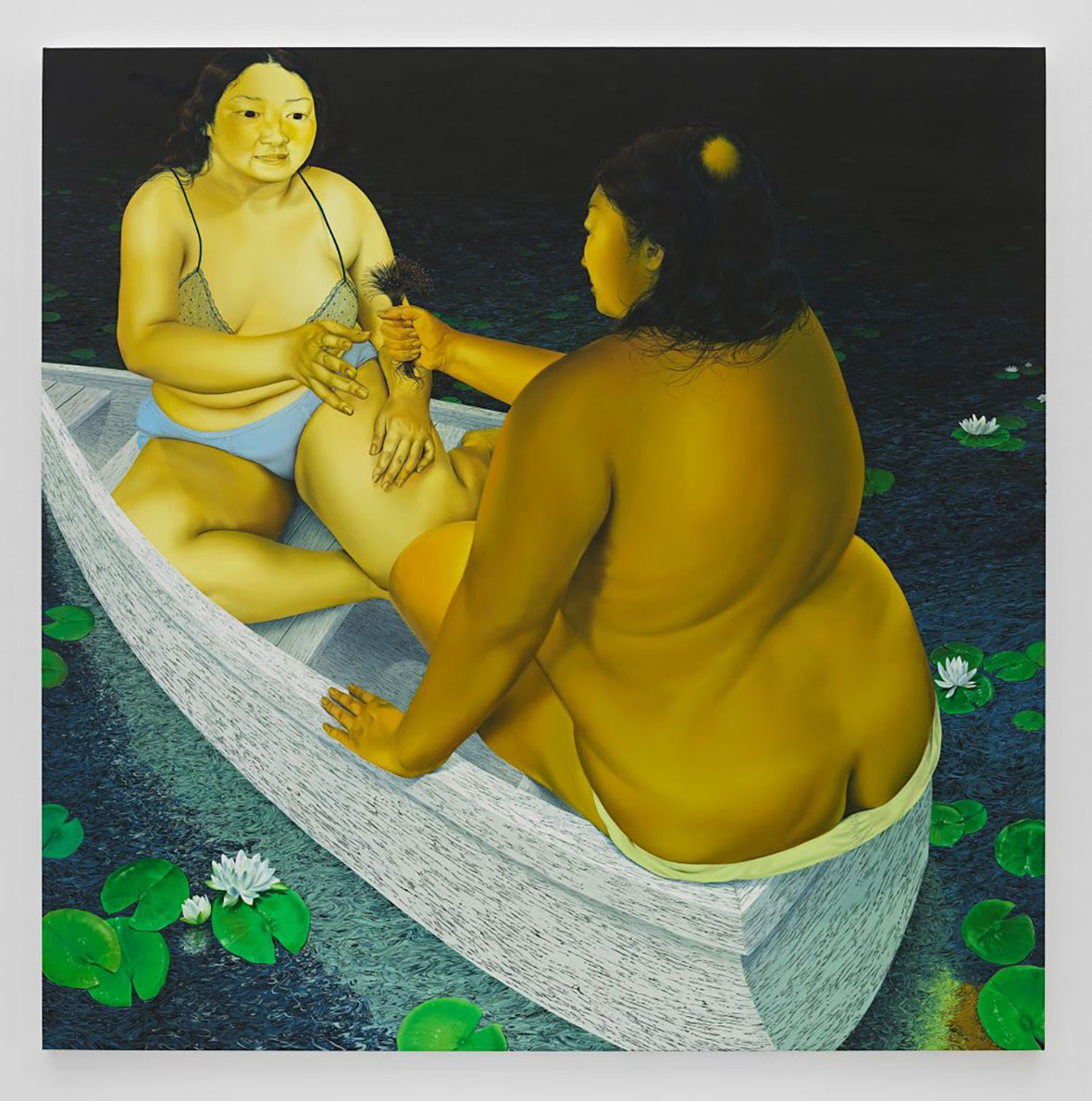
In Almost a Very Rare Thing, perhaps the artist’s most personal work, Gordon turns to an intimate struggle with trichotillomania to make sense of the disorder. Two figures sit silently in front of one another on a rocking boat in the dead of night. One of them is completely nude, while the other is clothed in minimal, mismatched underwear. The nude figure turns her back to the viewer, solemnly handing over a handful of hair to the apprehensive figure opposite to her. At the top of the nude figure head, there is a circular bald patch presumably from the hair she is giving away. They are surrounded by small lily pads scattered across the lake, eliciting a ritualistic meeting, an exchange that feels painful but anticipated. Gordon often alludes to her mental health battles in interviews as the topic comes up periodically in her paintings. This, too, is a confrontation with the self, albeit one that is more uncomfortable than the childish scenes that Gordon loves. The artist struggles with trichotillomania, a compulsive disorder in which one’s uncontrollable urge leads them to pull out their hair, eyelashes, or eyebrows. Gordon also delves into her life-long experience with OCD (Obsessive Compulsive Disorder), in which the individual is subjected to patterned intrusive thoughts that cause them to repeat certain actions or behaviors. Both conditions vary from one to another, yet, the experience often leaves people with heightened anxiety and hyper awareness among other side effects. Almost a Very Rare Thing is a powerful translation of Gordon’s inner battles, one that simmers under the surface of all the other characters she had assumed in other works. No one is making a splash, as both figures let the calm currents of the lake carry them through. Yet, something about the exchange leaves a simmering taste of mourning, a passing of pain from one to another. Whereas day time is reserved for the artist to explore uncensored and playful versions of herself as we have seen in Sore Loser or Garden Troll, the nighttime is reserved for intense introspection that ventures towards the artist’s deepest insecurities. Gordon articulates, “Having OCD, I’m very aware of how things fit on my body. When I was younger I was very sensitive to fabric and textures… I think that’s why in Almost a Very Rare Thing the butt crack is out. It’s very particular. And I was also very picky with clothes because I didn’t have the standard skinny body type.” Unlike her Asian American peers and counterparts, Gordon’s experience speaks to a larger theme of unbelonging, a denial of space, and a demoralizing rejection that plague Asian American thoughts.
《Almost a Very Rare Thing》(几近罕见)是 Sasha 一次极具个人特色的展示,她在作品中探讨了关于拔毛癖的话题,寻求观众对这种精神疾病的理解。画中描绘了某个夜深人静的时刻,两人静静地坐在一支摇曳的扁舟。其中一人全身赤裸,另一人身上的内衣则十分紧绷。赤裸的女人头顶露出一块儿斑秃,她将一缕头发交给对面的女人,接过头发的女人看起来忧心忡忡。整个场景看似某种仪式,给观众带来一种淡淡的痛苦。
在采访中,Sasha 多次提及自己的心理健康问题,并屡次体现在画中,是她与自我对抗的方式。比起 Sasha 通常描绘的那些充满孩子气的场景,这一幅作品则带有一丝不安的情绪。事实上,她本人患有拔毛癖,这是一种强迫症,患者会难以控制拔掉头发、睫毛或眉毛的冲动。她还深入剖析了自己与强迫症作斗争的经历。强迫症患者会受到模式化侵入性思想影响,不断重复某些动作或行为。这两种精神疾病虽不相同,但都会令人高度焦虑、意识过剩以及带来其他负面作用。
《Almost a Very Rare Thing》极力表现出 Sasha 内心的挣扎状态。两人交换头发的瞬间,一阵哀伤弥漫开来,仿佛痛苦在她们之间传递。在这位艺术家的画作中,白天的场景是她在探索自己无拘无束与俏皮诙谐的一面;而夜晚则是强烈的内省,大胆探索内心深处的不安。Sasha 说:“因为有强迫症,我对于碰触到身体的任何东西都格外注意。我此前对面料和纹理非常敏感,这也是为什么在《Almost a Very Rare Thing》中,角色会光着屁股。我变得非常挑剔,对于要穿的衣服更是如此,因为我并不是那种标准的纤瘦体型。”不同于大多数美籍亚裔同龄人,Sasha 内心所反映的是一个更广泛的话题,即困扰美籍亚裔人群的归属感缺失、自我否定和被排斥感。
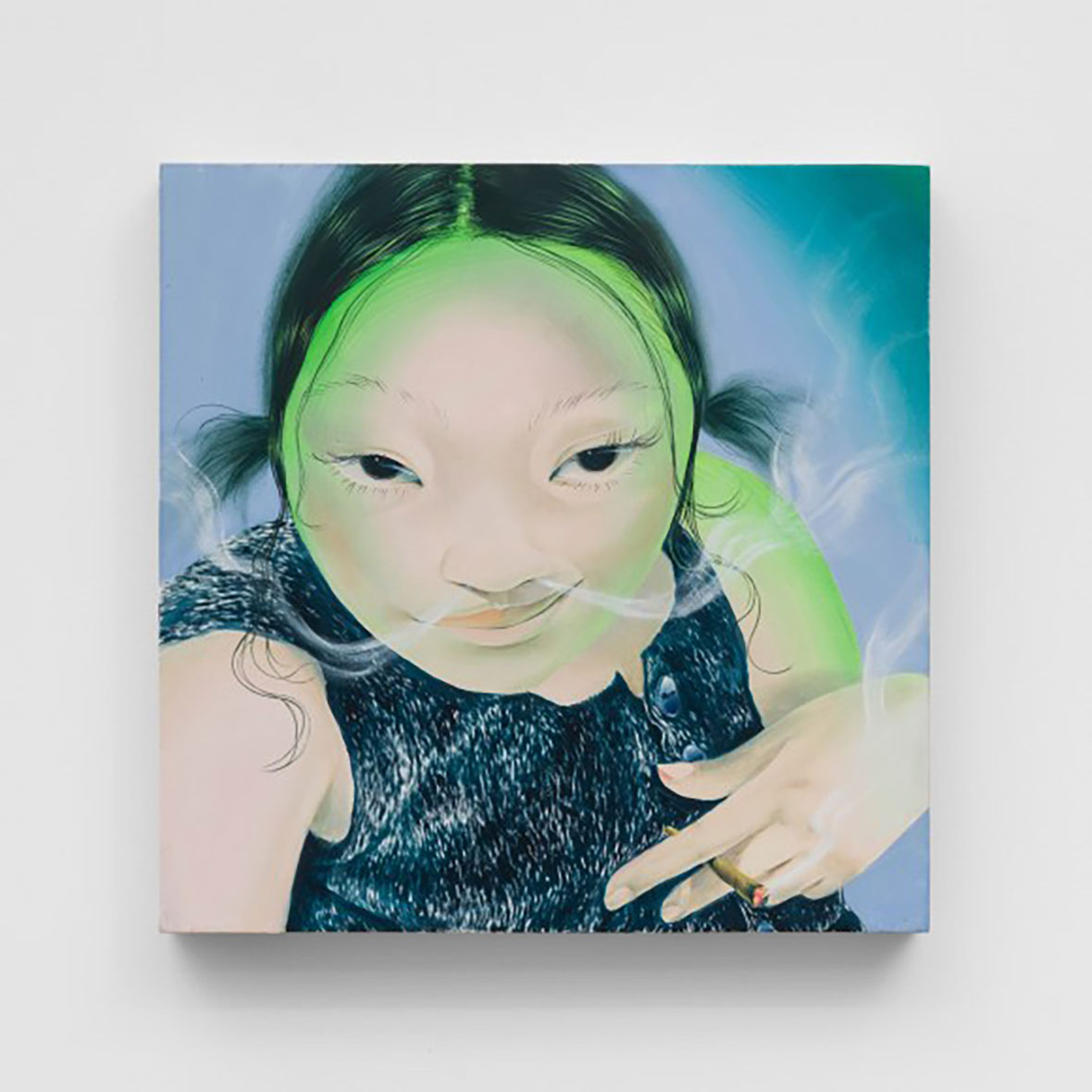
But Gordon opts to be an active participant of her own healing rather than a passive saboteur of her life. She paints versions of herself over and over to assert her own individuality as a gateway to radical self-love. She reflects, “Growing up, I guess I had a hard time seeing myself as a person. Painting myself o solidly is a way of making myself feel more permanent and present.” The artist refuses the impulses to shrink herself, as she had moved through the majority of life doing so. Rather, by painting herself as all the versions she longs to achieve, Gordon expands her own universe and manifest herself as a Renaissance woman, capable of taking up even more and more space as she had thought she was allowed to. There is Sasha Gordon as a masterful violinist in Concert Mistress, as the tennis player in Sore Loser, as a joint-blazing inspiration in Muse I, or as Boticelli Venus in Like Froth. Gordon is everything, everywhere, all at once because she is able to paint herself into these worlds that she felt had been shut off from her for her life. In My Friend Will Be Me, the artist reassures us that she is limitless on the canvas. Following the rite of passage that is the artist-in-studio portrait, My Friend Will Be Me is a gleeful glimpse into the joy of shapeshifting that art affords Gordon. A blue nude figure, presumably the artist herself, stands smiling widely as she finishes up a brushstroke on the half-finished painting in front of her. The artist’s apron covers the rest of her body but is cleverly and wittily tucked between her cleavage. The painting-inside-a-painting shows a refreshed woman rising up above some Japanese folding screens. In her natural habitat, the artist is airbrushed and glowing under the magnificent blue hue she has casted herself under. Gordon’s reliance on art as a tool of self-inspection results in boundless possibilities of what the artists can be once she is no longer constraint by the painful experiences that both shaped her and held her back. On the canvas, all the Sashas that Gordon ever dreamed of come alive.
Sasha 选择积极的自我疗愈,而不是自暴自弃。她一遍又一遍地描绘自己,以宣示自己的个性,从中习得自爱。“从小到大,我很难将自己视为一个完整的人。画自己,可以让我感受到自己真实的存在。”无论创作还是生活,她都拒绝渺小化自己,相反,则是将自己描绘成渴望成为的所有版本,拓展自己的宇宙,以文艺复兴时期的女性形象,占据更多的空间,她认为自己有权利这样做。
在作品《Concert Mistress》(音乐会情人)中,她是高超的小提琴手,在《Sore Loser》(输不起的人)中,她是网球运动员,在《Muse I》(我是缪斯)中,她是发光发热的灵感缪斯,在《Like Froth》(像泡沫一样),她是波提切利画的维纳斯。Sasha 可以是一切,无处不在,因为她可以用画笔,将自己融入那些曾将她挡之门外的世界。
在画作《My Friend Will Be Me》(我的朋友是我自己)中,Sasha 再次向观众证明,画布中的她可以成为任何人。《My Friend Will Be Me》一部艺术家工作室肖像作品,画中的所有蓝色裸体人物均是这位艺术家本人,Sasha 在作品里呈现了艺术带给自己不断变换身份的乐趣。她以艺术作为自我审视的工具,并以此呈现出无限可能,这种可能性恰恰反向为她自己带来许多疗愈。画布上,Sasha 所梦想成为的所有自己都跃然纸上。
Just like she did in Sore Loser, Gordon understands the two sides of the coin all too well. She knows the high of winning and the lows of losing, because she’s been both the huntsman and the prey. In the diptych The Archer, the forced target raises a pretend thumbs-up to her hunter, signifying that it was quite alright for them to keep going, for them to keep shooting at her, until they achieve their goal of hitting the apple placed at the top of her head. The left panel of the target is gloomy as the character’s expression darkens with dread. Her right arm is tied behind her back, alluding to the fact that she has no choice but to comply with her subjectification. Meanwhile, on the right panel, the archer confidently pulls back the string with a smirk, aiming with one eye closed, preparing to for another shot at her target. Both are half-nude and wearing blue jeans. This dichotomy lies at the heart of Gordon’s works: one gets the sense that she’s rooting for both sides, that she’s been on both sides, and that this very tension between two extremities is the beating pulse of her captivating canvas. The tug of war between different versions of Gordon materializes through her fears, as Gordon expresses her efforts to explain the disconnect she has been groomed to feel by a racial, heteronormative, and prejudiced world. Gordon quotes, “I’m trying to show this feeling of wrongness one has all the time – that feeling of wrongness also came through my queerness.” Caught in the stream of political debates, she adds, “I felt there is the “me” who is present but there’s also this other, external force that’s judging and controlling what I do.” The Archer implores the conflicting tendencies of one to subject themselves to pain because that’s what they have been taught their whole life. Gordon understands this deeply. She has held the bow but has also been hit by the arrow; she is both the archer and the prey.
All in all, the fun façade of Gordon’s poppy color palette and glossy figures reflect the difficult truths and painful journeys that Gordon had to unlearn. It is a weaving together of imagination as well as introspection, which Gordon understands cannot exist without one another in the route to radical self-love. It is, more important, a vessel in which she uses to carve out a safe space where inhibitions take charge instead of reservations. Speaking of one of her inspiration, photographer Ren Huang, Gordon writes, “It’s so risqué, and there’s something bizarre about his subjects’ poses; I feel like no one has shown Asian people doing these weird movements. I always thought Asian people had to be under the radar and assimilate to their surroundings because I had to do that. I thought I couldn’t be loud or stand out – it felt very unsafe. But his photos are so odd and almost gruesome. It’s beautiful that he could capture that through people who looked like me. It made me want to make equally strange paintings.” Though the strange forms Gordon loves to paint are figments of her imagination, there’s nothing unreal and insincere about her fierce self-love and acceptance, which should inspire us all to take ourselves less seriously, and embrace ourselves more authentically.
创作中,Sasha 对不同立场的心境保有同理心,正如在作品《Sore Loser》中,她知道胜利的兴奋,也知道失败的沮丧,她既是猎人,也是猎物。在双联画《The Archer》(弓箭手)中,作为目标的女孩向着猎人竖起大拇指,鼓励他们朝自己扣下扳机,直到击中放在她头顶的苹果为止。画面中的角色露出一副看透凡尘的淡然,她的右臂被绑在背后,暗示别无选择,只能接受他人的物化。与此同时,另一副画作中,弓箭手正表情谄媚地拉弓上旋,作出瞄准的姿势。
这种二分法是 Sasha 作品惯用的创作方式:仿佛支持两种立场。而两种极端之间的张力正是其作品引人入胜的魅力所在。她试图通过拉锯战,解释一个充满种族主义、异性恋和偏见的世界如何使自己逐渐滋生出的这种决裂感。Sasha 表示:“我想表达一个人无时无刻的那种羞愧感,这种羞愧感来自我的感受。”对于被裹挟在政治话题洪流中的自己,她补充说:“我觉得每一个个体的行为,都会受到其他外部力量的判断和控制。”《The Archer》(弓箭手)揭示了一个人顺从地接受痛苦的矛盾倾向,暗指他们一直以来所接受的社会教育。Sasha 对此深有体会。她曾举起过弓箭,也曾被箭袭击;她既是弓箭手,也是猎物。
总而言之,Sasha 通过活泼色调与皮肤光滑的角色呈现诙谐的画面,反映出她努力忘掉和摆脱的痛苦真相与经历。这是想象与内省的交织,在 Sasha 看来,要实现彻底的自爱,两者缺一不可。更重要的是,绘画是她为自己打造的安全角落,这里更多的是抑制,而不是来自外界的阻遏。
谈到启发她创作的摄影师任航,Sasha 写道:“他的作品非常露骨,照片中的拍摄对象总是摆出奇特的姿势,而在他之前,好像还没有人曾拍过亚洲人做这些奇怪的姿势。我一直以为,亚洲人就应该保持低调并融入周围的环境。我以为自己不能太出众,否则会感觉很不安全。但他的照片却如此奇怪,令人寒毛直立。他拍摄了性少数亚裔群体与众不同的一面,这是极其美妙的事,也引发我开始构想同样奇怪的创作。” Sasha 的奇怪场景虽然纯属虚构,但其中透露的强烈自爱与自我接纳,完全来自她的真实体验与经历,也激励着我们所有人降低自我意识,拥抱真实的自己。
Like our stories? Follow us on Facebook and Instagram.
Instagram: @sashaagordon
Contributor: Uyen Dinh
Chinese Translation: Olivia Li

